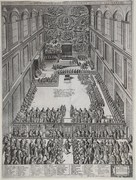The Fondo Cappella Sistina in RISM
Thomas Schmidt
Thursday, October 8, 2020

We have received the following from Thomas Schmidt (Dean of Music, Humanities and Media, Professor of Musicology, University of Huddersfield):
The catalogue of the music sources of the Fondo Cappella Sistina in the Biblioteca Apostolica Vaticana goes back to a research project under the direction of Ludwig Finscher, funded by the Heidelberg Academy of Sciences between 1998 and 2002. Work on a catalogue raisonée of the Fondo, setting new codiological standards, took place between 1995 and 2002 by Thomas Schmidt (manuscripts) and Gottfried Heinz (printed editions), with a planned book publication in the catalogue series of the Vatican library; however, due to the end of the project’s funding and changes in personnel, this publication never came to pass. It is therefore all the more gratifying that the data is now finally publicly accessible in the context of the RISM online catalogue.
Since the project remained a torso, the data density of the individual entries varies greatly. All entries up to CS 80 and all manuscripts with polyphonic music copied before 1600 (the chant manuscripts of the Fondo, which were also cataloged, are not part of the RISM remit and thus not accessible here) are recorded completely and in the level of detail developed for the printed catalog. For the remaining entries, the catalogue provides the basic data on the codices and the repertoire, initially taken from LlorensS 1960 and only partially updated.
For the fully described entries, the breadth and depth of the codicological and palaeographic data (including gathering structures, preparation of the page, copying space, layout, notation, state of preservation, etc.) goes far beyond the RISM cataloging scheme; this information is available in the “Notes” field. The detailed descriptions are based on an examination of the codices in the Biblioteca Apostolica Vaticana, with a few exceptions where the poor condition of the volumes made this impossible; this examination took place between 1995 and 2002 and therefore represents that specific chronological state of the collection. This is of particular importance as a number of the codices in question - almost all of them copied on paper and often in a precarious state of preservation - have in the meantime been extensively restored and newly bound (the latter often resulting in the loss of the original gathering structure, as the manuscripts are almost all made from individual sheets that were combined to form artificial bifolia). In these cases, the descriptions represent an older status of preservation, often closer to the original and in any case now lost.
Image: Ambrogio Brambilla, La Cappella Sistina (courtesy of the author)
Share Tweet Email
Catégorie: Collections de bibliothèques

